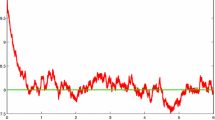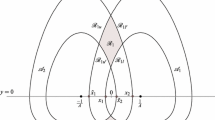Abstract
The goal of this paper is to motivate the need and lay the foundation for the analysis of stochastic epidemiological models with seasonal forcing. We consider stochastic SIS and SIR epidemic models, where the internal noise is due to the random interactions of individuals in the population. We provide an overview of the general theoretic framework that allows one to understand noise-induced rare events, such as spontaneous disease extinction. Although there are many paths to extinction, there is one path termed the optimal path that is probabilistically most likely to occur. By extending the theory, we have identified the quasi-stationary solutions and the optimal path to extinction when seasonality in the contact rate is included in the models. Knowledge of the optimal extinction path enables one to compute the mean time to extinction, which in turn allows one to compare the effect of various control schemes, including vaccination and treatment, on the eradication of an infectious disease.










Similar content being viewed by others
References
Sharp, P.A., Cooney, C.L., Kastner, M.A., Lees, J., Sasisekharan, R., Yaffe, M.B., Bhatia, S.N., Jacks, T.E., Lauffenburger, D.A., Langer, R., Hammond, P.T.: The Third Revolution: The Convergence of the Life Sciences, Physical Sciences, and Engineering. Massachusetts Institute of Technology, Cambridge (2011)
Sharp, P.A., Langer, R.: Promoting convergence in biomedical science. Science 333(6042), 527–527 (2011)
Anderson, R.M., May, R.M., Anderson, B.: Infectious Diseases of Humans: Dynamics and Control, vol. 28. Wiley Online Library, London (1992)
Bailey, N.T., et al.: The Mathematical Theory of Infectious Diseases and its Applications. Charles Griffin & Company Ltd., London (1975)
Bartlett, M.S.: An Introduction to Stochastic Processes: with Special Reference to Methods and Applications. The University Press, Cambridge (1955)
Hamer, W.H.: The Milroy Lectures on Epidemic Disease in England: The Evidence of Variability and of Persistency of Type. Bedford Press, London (1906)
Kermack, W.O., McKendrick, A.G.: A contribution to the mathematical theory of epidemics. Proc. R. Soc. Lond. Ser. A 115, 700–721 (1927)
Ross, R., Thomson, D.: A case of sleeping sickness studied by precise enumerative methods: regular periodical increase of the parasites disclosed. Proc. R. Soc. Lond. Ser. B 82(557), 411–415 (1910)
Soper, H.E.: The interpretation of periodicity in disease prevalence. J. R. Stat. Soc. 92(1), 34–73 (1929)
Durrett, R., Levin, S.: The importance of being discrete (and spatial). Theor. Popul. Biol. 46(3), 363–394 (1994)
Tsimring, L.S.: Noise in biology. Rep. Prog. Phys. 77(2), 026,601 (2014)
Gardiner, C.W.: Handbook of Stochastic Methods for Physics, Chemistry and the Natural Sciences. Springer, New York (2004)
Van Kampen, N.G.: Stochastic Processes in Physics and Chemistry, vol. 1. Elsevier, Amsterdam (1992)
Assaf, M., Meerson, B.: Extinction of metastable stochastic populations. Phys. Rev. E 81(2), 021,116 (2010)
Dykman, M., Mori, E., Ross, J., Hunt, P.: Large fluctuations and optimal paths in chemical kinetics. J. Chem. Phys. 100(8), 5735–5750 (1994)
Elgart, V., Kamenev, A.: Rare event statistics in reaction–diffusion systems. Phys. Rev. E 70, 041,106 (2004)
Forgoston, E., Bianco, S., Shaw, L.B., Schwartz, I.B.: Maximal sensitive dependence and the optimal path to epidemic extinction. Bull. Math. Biol. 73, 495–514 (2011)
Gang, H.: Stationary solution of master equations in the large-system-size limit. Phys. Rev. A 36(12), 5782 (1987)
Kessler, D.A., Shnerb, N.M.: Extinction rates for fluctuation-induced metastabilities: a real space WKB approach. J. Stat. Phys. 127(5), 861–886 (2007)
Kubo, R., Matsuo, K., Kitahara, K.: Fluctuation and relaxation of macrovariables. J. Stat. Phys. 9(1), 51–96 (1973)
Nieddu, G., Billings, L., Forgoston, E.: Analysis and control of pre-extinction dynamics in stochastic populations. Bull. Math. Biol. 76(12), 3122–3137 (2014)
Schwartz, I.B., Forgoston, E., Bianco, S., Shaw, L.B.: Converging towards the optimal path to extinction. J. R. Soc. Interface 8(65), 1699–1707 (2011)
Nieddu, G.T., Billings, L., Kaufman, J.H., Forgoston, E. and Bianco, S.: Extinction pathways and outbreak vulnerability in a stochastic Ebola model. J. Royal Soc. Interface 14(127), 20160847 (2017)
Assaf, M., Kamenev, A., Meerson, B.: Population extinction in a time-modulated environment. Phys. Rev. E 78(4), 041,123 (2008)
Black, A.J., McKane, A.J.: WKB calculation of an epidemic outbreak distribution. J. Stat. Mech. Theory Exp. 2011(12), P12,006 (2011)
Wentzell, A.: Rough limit theorems on large deviations for Markov stochastic processes, I. Theory Probab. Appl. 21, 227–242 (1976)
Doering, C.R., Sargsyan, K.V., Sander, L.M.: Extinction times for birth–death processes: exact results, continuum asymptotics, and the failure of the Fokker–Planck approximation. Multiscale Model. Simul. 3(2), 283–299 (2005)
Dykman, M.I., Schwartz, I.B., Landsman, A.S.: Disease extinction in the presence of random vaccination. Phys. Rev. Lett. 101(7), 078,101 (2008)
Billings, L., Mier-y Teran-Romero, L., Lindley, B., Schwartz, I.B.: Intervention-based stochastic disease eradication. PloS ONE 8(8), e70211 (2013)
Gillespie, D.T.: A general method for numerically simulating the stochastic time evolution of coupled chemical reactions. J. Comput. Phys. 22(4), 403–434 (1976)
London, W.P., Yorke, J.A.: Recurrent outbreaks of measles, chickenpox and mumps I. Seasonal variation in contact rates. Am. J. Epidemiol. 98(6), 453–468 (1973)
Schwartz, I.B., Smith, H.: Infinite subharmonic bifurcation in an seir epidemic model. J. Math. Biol. 18(3), 233–253 (1983)
Billings, L., Bollt, E.M., Schwartz, I.B.: Phase-space transport of stochastic chaos in population dynamics of virus spread. Phys. Rev. Lett. 88(23), 234,101 (2002)
Bollt, E.M., Billings, L., Schwartz, I.B.: A manifold independent approach to understanding transport in stochastic dynamical systems. Phys. D Nonlinear Phenom. 173(3), 153–177 (2002)
Rand, D., Wilson, H.: Chaotic stochasticity: a ubiquitous source of unpredictability in epidemics. Proc. R. Soc. Lond. B: Ser. B 246(1316), 179–184 (1991)
Dykman, M.I., Golding, B., McCann, L.I., Smelyanskiy, V.N., Luchinsky, D.G., Mannella, R., McClintock, P.V.E.: Activated escape of periodically driven systems. Chaos Interdiscip. J. Nonlinear Sci. 11(3), 587–594 (2001)
Maier, R.S., Stein, D.L.: Noise-activated escape from a sloshing potential well. Phys. Rev. Lett. 86, 3942–3945 (2001)
Lindley, B.S., Schwartz, I.B.: An iterative action minimizing method for computing optimal paths in stochastic dynamical systems. Phys. D Nonlinear Phenom. 255, 22–30 (2013)
Ren, E.W., Vanden-Eijnden, E.: Minimum action method for the study of rare events. Commun. Pure Appl. Math. 57, 637–656 (2004)
Heymann, M., Vanden-Eijnden, E.: The geometric minimum action method: a least action principle on the space of curves. Commun. Pure Appl. Math. 61, 1052–1117 (2004)
Bauver, M., Forgoston, E., Billings, L.: Computing the optimal path in stochastic dynamical systems. Chaos Interdiscip. J. Nonlinear Sci. 26(8), 083,101 (2016)
Fine, P.E., Clarkson, J.A.: Measles in England and Walesi: an analysis of factors underlying seasonal patterns. Int. J. Epidemiol. 11(1), 5–14 (1982)
Rohani, P., Keeling, M.J., Grenfell, B.T.: The interplay between determinism and stochasticity in childhood diseases. Am. Nat. 159(5), 469–481 (2002)
Glendinning, P., Perry, L.P.: Melnikov analysis of chaos in a simple epidemiological model. J. Math. Biol. 35(3), 359–373 (1997)
Khasin, M., Dykman, M., Meerson, B.: Speeding up disease extinction with a limited amount of vaccine. Phys. Rev. E 81(5), 051,925 (2010)
Author information
Authors and Affiliations
Corresponding author
Additional information
EF was supported by the National Science Foundation award CMMI-1233397. This material is based upon work while LB was serving at the National Science Foundation. We thank the reviewers whose comments have improved the article.
Appendix A: Iterative Action Minimizing Method (IAMM)
Appendix A: Iterative Action Minimizing Method (IAMM)
To analyze the dynamics of spontaneous escape from an endemic state, we numerically compute the optimal path, which is a zero-energy curve for the Hamiltonian that connects two steady state saddle points. We use the Iterative Action Minimizing Method (IAMM) [38], a numerical scheme based on Newton’s method. The IAMM is useful in the general situation where a path connecting steady states \(C_a\) and \(C_b\) starts at \(C_a\) at \(t=-\infty \) and ends at \(C_b\) at \(t=+\infty \). A time parameter t exists such that \(-\infty<t<\infty \). For this method, we require a numerical approximation of the time needed to leave the region of \(C_a\) and arrive in the region of \(C_b\). Therefore, we define a time \(T_{\epsilon }\) such that \(-\infty<-T_{\epsilon }<t<T_{\epsilon }<\infty \). Additionally, \(C(-T_{\epsilon }) \approx C_a\) and \(C(T_{\epsilon }) \approx C_b\). In other words, the solution stays very near the equilibrium \(C_a\) for \(-\infty <t\le -T_{\epsilon }\), has a transition region from \(-T_{\epsilon }<t<T_{\epsilon }\), and then stays near \(C_b\) for \(T_{\epsilon }<t<+\infty \). The interval \([-T_{\epsilon },T_{\epsilon }]\) is discretized into n segments using a uniform step size \(h=(2T_{\epsilon })/n\) or a suitable non-uniform step size \(h_k\). The corresponding time series is \(t_{k+1}=t_k+h_k\).
The derivative of the function value \(\mathbf {q}_k\) is approximated using central finite differences by the operator \(\delta _h\) given as
Clearly, if a uniform step size is chosen then Eq. (39) simplifies to the familiar form given as
Thus, one can develop the system of nonlinear algebraic equations
which is solved using a general Newton’s method. We let
be an extended vector of 2nN components that contains the \(j\mathrm{th}\) Newton iterate, where N is the number of populations. When \(j=0\), \(\mathbf {q}_0(\mathbf {x,p})\) provides the initial “guess” as to the location of the path that connects \(C_a\) and \(C_b\). Given the \(j\mathrm{th}\) Newton iterate \(\mathbf {q}_j\), the new \(\mathbf {q}_{j+1}\) iterate is found by solving the linear system
where \(\mathbf {F}\) is the function defined by Eq. (41) acting on \(\mathbf {q}_{j}\), and \(\mathbf {J}\) is the Jacobian. Equation (43) is solved using LU decomposition with partial pivoting.
Rights and permissions
About this article
Cite this article
Billings, L., Forgoston, E. Seasonal forcing in stochastic epidemiology models. Ricerche mat 67, 27–47 (2018). https://doi.org/10.1007/s11587-017-0346-8
Received:
Revised:
Published:
Issue Date:
DOI: https://doi.org/10.1007/s11587-017-0346-8




